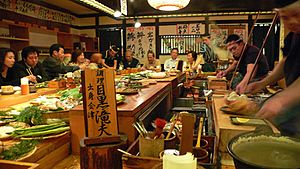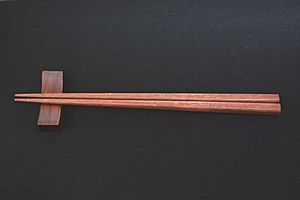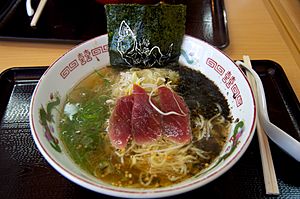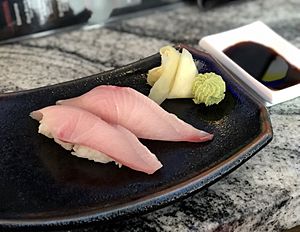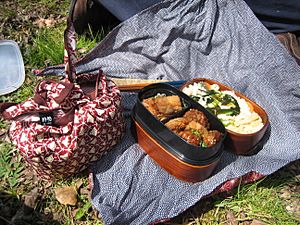Customs and etiquette in Japanese dining facts for kids
When you eat in Japan, there are special rules and customs about how to behave. These rules are called etiquette, and they help everyone have a good time while sharing a meal. Knowing these customs shows respect for Japanese culture and the people you are eating with.
Contents
Showing Thanks: Before and After Meals
In Japan, it's polite to say a special phrase before you start eating: itadakimasu (いただきます, literally, "I humbly receive"). This phrase is like saying "bon appétit" or "grace" in other cultures. It means you are thankful for the food and for everyone who helped prepare it. This includes farmers, chefs, and even the plants and animals that became part of your meal.
When you say itadakimasu, you can put your hands together in front of your chest. It's also nice to say something good about how the food looks, because Japanese people care a lot about how food is arranged. Before you touch your food, wait for the oldest person at the table to start eating. After the meal, it's important to say gochisōsama-deshita (ごちそうさまでした, lit. "it was a feast") to thank your host or the restaurant staff.
Eating Your Meal: What to Do
It's okay not to finish every single bite of your meal in Japan. Sometimes, leaving a little food tells the host you are full and don't need more. But if you finish everything, especially your rice, it shows you really enjoyed it. Kids are often encouraged to eat every last grain of rice. It's not polite to pick out only certain ingredients from a dish and leave the rest. Always chew your food with your mouth closed.
You can lift your soup and rice bowls close to your mouth to avoid spilling. Miso soup is usually drunk right from its small bowl. For bigger soups, you might get a spoon. You will always be given hashi (chopsticks) to eat with. If you're eating hot noodles, you can blow on them to cool them down after lifting them from the soup. It's also fine to slurp certain foods, like ramen or soba noodles. This is seen as a way to enjoy the flavor more. However, don't slurp Western-style noodles like pasta.
Rice is often eaten plain or with toppings like nori (dried seaweed) or furikake (a seasoning). Sometimes, you might get a raw egg, nattō (sticky fermented soybeans), or tsukemono (preserved vegetables) to mix into your rice.
Using Soy Sauce and Sushi
Pouring soy sauce directly over plain white rice is not a Japanese custom. Also, don't pour too much soy sauce over sashimi or sushi. Soy sauce is meant to add a little flavor, not cover up the taste of the food. You'll get a small dish for soy sauce. Pour only a little at first, and add more if you need it. Pouring too much is seen as wasteful.
When eating nigiri-zushi (sushi with a topping), dip the fish or topping side into the soy sauce, not the rice. This stops the rice from soaking up too much sauce. It's also not polite to mix wasabi (green horseradish) into your soy sauce dish. Instead, put a tiny bit of wasabi directly on the sushi piece after you've dipped it. At sushi restaurants, it's perfectly fine to use your fingers to eat nigiri-zushi instead of chopsticks.
Chopsticks: The Right Way to Use Them
Using chopsticks (hashi) correctly is very important in Japan. Here are some key rules:
- Hold them right: Hold your chopsticks towards the end, not in the middle.
- Resting them: When you're not using your chopsticks, lay them down in front of your meal with the tips pointing to the left.
- No sticking up: Never stick your chopsticks straight up in your rice. This is called Tate-bashi and reminds people of incense sticks used in funerals.
- No spearing: Don't use your chopsticks to spear food.
- No biting: It's bad manners to bite your chopsticks.
- Passing food: Don't pass food directly from your chopsticks to someone else's. This is only done at funerals. If you need to share food, pick it up with the top (clean) end of your chopsticks and place it on a small plate for the other person to pick up.
- No waving: Don't wave your chopsticks around in the air or play with them.
- No moving dishes: Don't use your chopsticks to move plates or bowls.
- Decide first: Don't hover your chopsticks over different dishes while trying to decide what to eat. This is called Mayoi-bashi and shows impatience. Decide what you want before you pick it up.
- No pointing: Don't point your chopsticks at someone.
- No dripping: Make sure sauce or liquid doesn't drip from your food or chopsticks onto the table. This is called Namida-bashi and is seen as messy.
- Put them down to talk: Put your chopsticks down on the table before you start talking. Don't use them to gesture.
When you pick up a bowl, hold it close to your mouth with your left hand while you eat with chopsticks in your right hand. The bowl shouldn't touch your mouth, except when you're drinking soup.
Sharing Food and Being Polite
When you take food from a dish that everyone is sharing, it's polite to turn your chopsticks around and use the clean, top end to pick up the food. This is more hygienic. Some places might even provide separate chopsticks for serving.
It's customary to eat all the rice you are given. Being a picky eater is generally not liked, and it's not common to ask for special requests or changes to your meal at restaurants. This is especially true if someone is hosting you for dinner. After you finish eating, try to put all the dishes back where they were at the start of the meal. This includes putting lids back on dishes and placing your chopsticks on their holder or back into their paper wrapper.
Special Towels: Oshibori
Before you eat at most Japanese restaurants, you'll be given a rolled hand towel called an oshibori. This towel is for cleaning your hands before you start your meal. It's considered rude to use it to wipe your face or neck, though some men might do this in very casual places. When a server hands you an o-shibori, accept it with both hands. After you're done, fold or roll it up and place it back on the table. Don't use it to wipe up spills on the table.
Sitting at the Table
Many Japanese restaurants and homes have Western-style tables and chairs. However, you'll also find traditional low tables with cushions, often on tatami floors. Tatami mats are made of straw and can be easily damaged, so you must always take off your shoes before stepping on them.
If you're dining in a traditional tatami room, sitting upright on the floor is common. For casual settings, boys and men usually sit with their legs crossed. Girls and women typically sit with both legs to one side. The most formal way to sit for everyone is a kneeling style called seiza.
When you go to a restaurant, the host will show you to your seat. The most important or oldest guest usually sits farthest from the entrance, often in the center of the table. In a home, the main guest also sits farthest from the entrance. If there's a special alcove called a tokonoma in the room, the guest sits in front of it. The host sits closer to the entrance.
Common Mistakes to Avoid
If your Japanese food has clams, don't put the empty shells in a separate bowl. Instead, place them back inside the bowl where the food was originally served. If you leave your chopsticks on the table after a meal, it might look like you haven't finished eating. It's polite to place them sideways across your plate or bowl when you're done. Talking too much while eating is not common; a little silence during the meal is valued. So, try not to force conversations while everyone is eating.
Food and Etiquette: Specific Dishes
Ramen Noodles
When you eat ramen or similar noodle soups, it's okay to make slurping sounds. This is actually a way to show you're enjoying the meal and helps cool the noodles, making them taste better. However, loud munching or burping is not polite. You should use chopsticks for the noodles and toppings, and a spoon for the soup.
Sushi
Sushi is very famous! You can eat sushi with your bare hands, but sashimi (just the fish slices) should be eaten with chopsticks. If you have nigiri-sushi (sushi with a fish topping) and soy sauce, pick up the sushi and dip only the fish topping into the soy sauce, not the rice. If the rice gets too much soy sauce, it changes the taste and can make the sushi fall apart. It's not a huge problem if a few rice grains float in the soy sauce, but it's better to avoid it. Don't pour a lot of soy sauce into your dish; just a small amount is enough. Wasting food is not good in Japan.
Bentō Box Meals
Bentō are boxed meals that are very common in Japan, especially for lunch. Parents often spend a lot of time making bentō for their children, arranging the food in a beautiful way. A bentō might look like a work of art, and it's expected that you eat everything inside.
Parents often try to make their bentō special, sometimes even cutting food into fun shapes like leaves or flowers. It's common to see many different small dishes inside one bentō. Parents also try to make sure the food is something their child will enjoy, so they eat it all.
Images for kids


